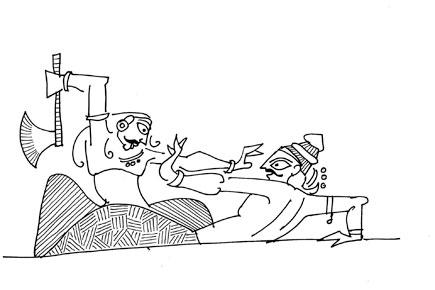Mahatma Gandhi found inspiration for his satyagraha or non-violent protest in the Gita. Balgangadhar Tilak on the other hand found in Gita justification of violence if the intent and objective is righteous

Devlok, Devdutt Pattanaik, Bhagvad Gita, violence, Opinion, Columnists
 Mahatma Gandhi found inspiration for his satyagraha or non-violent protest in the Gita. Balgangadhar Tilak on the other hand found in Gita justification of violence if the intent and objective is righteous. So does Gita preach violence or not?
Mahatma Gandhi found inspiration for his satyagraha or non-violent protest in the Gita. Balgangadhar Tilak on the other hand found in Gita justification of violence if the intent and objective is righteous. So does Gita preach violence or not?
I remember an essay on Gita written by Wendy Doniger in which she spoke of how Gita goes out of its way to justify violence. She also quoted Romila Thapar as to how Buddha would have responded to Arjuna’s crisis differently. You can imagine how this essay would upset many Hindus, especially those who keep telling their children how Hinduism preaches non-violence and hence, vegetarianism.
ADVERTISEMENT
The contrast between Buddhism and Hinduism is stark. The founder of Buddhism walked away from his family and his kingdom to become a hermit who rejected desire, sex and violence. By contrast, Hinduism insisted that a man perform his duty based on caste rules. Whatever be his views on desire, sex and violence, he had to marry, produce children, take care of his family by pursuing the family profession. He who was born in a warrior family had to go to war and fight. He who was born in a butcher family had to slaughter animals for food. Ramayana and Mahabharata valourise not war so much as the pursuit of social obligation, even while engaging in long discussions on the morality of war.

Illustration/ Devdutt Pattanaik
At the heart of this controversy is the fundamental question: is violence good or bad? To answer this question, we have to pay attention to role of violence in nature and culture. In nature, animals survive by indulging in violence. Herbivores bite and tear plants. Carnivores hunt animals. Violence is used to establish pecking order, mark territory and isolate mates. Culture is also established through violence. Forests are burned to create fields. Riverbanks are broken to create canals. Mountains are blasted to find minerals. Animals are castrated to serve as beasts of burden. Thus violence is intrinsic to both nature and culture. Violence enables animals to find food. Humans use violence to generate wealth and lay claim to property.
Buddhism has a monastic tilt. A monk rejects wealth and property. So he rejects violence. But society is not made of monks. How does one help people who have no choice but to participate in violence? How does one help a soldier who has to fight in a war or a policeman who has to catch a criminal? We may not use violence to offend, but we have to use violence to defend and survive. We do not like being at the receiving end of violence, but we do know that violence is sometimes necessary to create a civil society.
Today, Western media is horrified that its pacifist understanding of Buddhism, constructed by its dealings with Dalai Lama, is being challenged by brutal violence perpetrated by Buddhist leaders in Burma and Sri Lanka. Here the question is not about outgrowing desire, it is about wealth and property, which are essential aspects of human existence. As long as we want wealth and property, there is no escaping violence. And violence thus perpetrated has consequences that we are obliged to suffer. Gita recognises this.
The author writes and lectures on relevance of mythology in modern times, and can be reached at devdutt@devdutt.com
The views expressed in this column are the individual’s and don’t represent those of the paper.
 Subscribe today by clicking the link and stay updated with the latest news!" Click here!
Subscribe today by clicking the link and stay updated with the latest news!" Click here!







